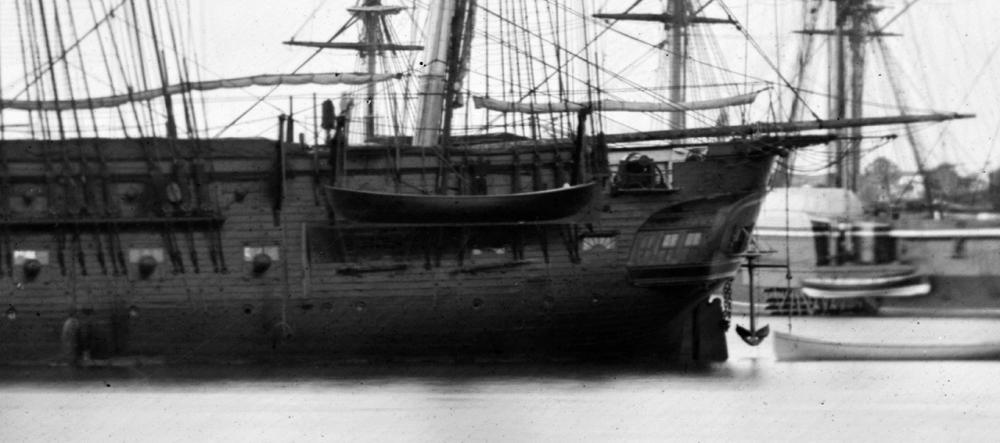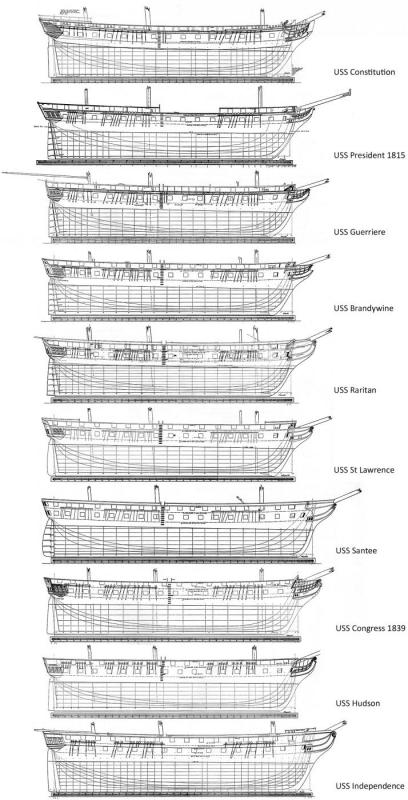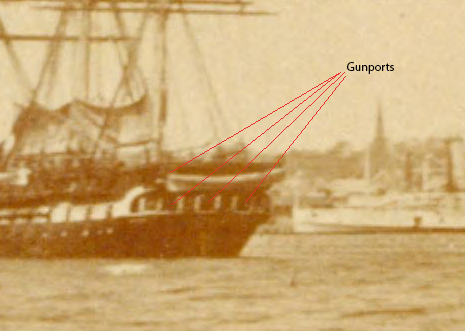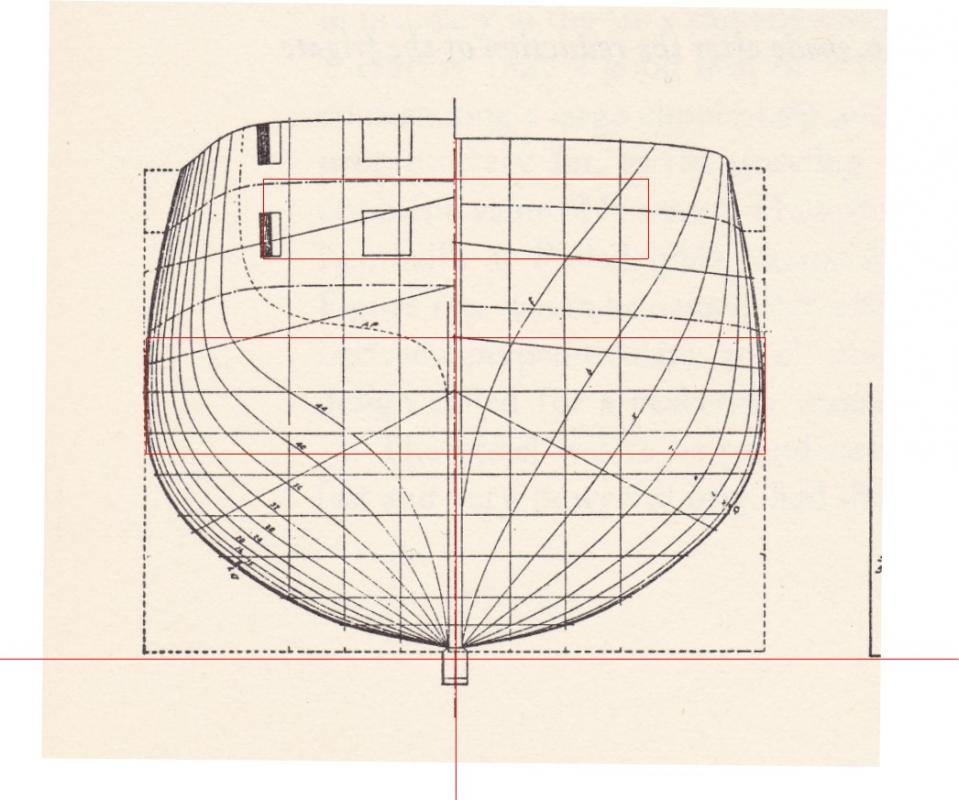
Talos
Members-
Posts
413 -
Joined
-
Last visited
Content Type
Profiles
Forums
Gallery
Events
Everything posted by Talos
-
American sailing warships with no plans or records
Talos replied to CharlieZardoz's topic in Nautical/Naval History
Hmm, not bad. The railing on that one reminds me of the flow of New York and Philadelphia's draughts. Where they continue unbroken until getting to the bits abaft the cathead. You can see what I mean here in the comparison I did.- 401 replies
-
- John Adams
- Alliance
-
(and 3 more)
Tagged with:
-
American sailing warships with no plans or records
Talos replied to CharlieZardoz's topic in Nautical/Naval History
Looking at the plans, the Brandywine-class frigates have a very flat stern with rounded corners. Portsmouth is closer to Constellation. Looking at Germantown again though, with her quarter galleries on, her stern almost looks flat (despite not being so). Explains why she and Portsmouth only have two stern ports and no quarter ports too. The structure of the hull itself looks in between Brandywine and the Hartford style. You can see what I'm talking about with Germantown here.- 401 replies
-
- John Adams
- Alliance
-
(and 3 more)
Tagged with:
-
American sailing warships with no plans or records
Talos replied to CharlieZardoz's topic in Nautical/Naval History
I almost wonder if it got added around 1876 with the US Centenial that year. Lots of patriotic imagery. That's just a total guess on my part though. Notice they also added two smaller star badges on the back of the quarterdeck, which are blank in Skerrett's drawing. @frolick Her plans depict her without any quarter galleries at all. If they were added on later (such as when she got the spar deck), it might account for her stern being like that. Albany was the only one of that group to be built with a square stern. EDIT: Just to muddle the waters more, her stern looks pretty round to me here.- 401 replies
-
- John Adams
- Alliance
-
(and 3 more)
Tagged with:
-
American sailing warships with no plans or records
Talos replied to CharlieZardoz's topic in Nautical/Naval History
Yeah, no kidding. Unrelated, a nice shot of Portsmouth and Lancaster in ordinary in 1894, giving a good view of the sloop's stern. Big carving!- 401 replies
-
- John Adams
- Alliance
-
(and 3 more)
Tagged with:
-
American sailing warships with no plans or records
Talos replied to CharlieZardoz's topic in Nautical/Naval History
She was a training ship and not going to go into battle, probably moored for good by the time that was taken, so it's no surprise it's so heavily decorated and furnished.- 401 replies
-
- John Adams
- Alliance
-
(and 3 more)
Tagged with:
-
American sailing warships with no plans or records
Talos replied to CharlieZardoz's topic in Nautical/Naval History
That would be the I.L. Snow shipyard in Rockland, Maine where Sam Ladley here lives. Best place to start investigating.- 401 replies
-
- John Adams
- Alliance
-
(and 3 more)
Tagged with:
-
American sailing warships with no plans or records
Talos replied to CharlieZardoz's topic in Nautical/Naval History
Another interesting photo, this one from the US Navy Heritage and History Command, Sabine's salvaged billethead. http://www.history.navy.mil/our-collections/photography/numerical-list-of-images/nhhc-series/nh-series/USN-901000/USN-901319.html And another one of Santee's gundeck, from further aft this time. And Santee's captain's cabin. Santee's gundeck looking aft.- 401 replies
-
- John Adams
- Alliance
-
(and 3 more)
Tagged with:
-
American sailing warships with no plans or records
Talos replied to CharlieZardoz's topic in Nautical/Naval History
I haven't found any yet. Of thse windows, I see three patterns in that picture. The first two on the left have three panes with vertical borders between them and the cannon still filling the port, then one with only two panes and one vertical border. The guns on the other three are removed, maybe turned sideways against the hull, and the window has an almost sunburst pattern to it. They appear to be half-ports too, but the ports on those three windows don't have the cutout on the lower half for the cannon barrel. I can probably draw up some sketches of them if need be. I imagine they were there for those two very reasons too. Those should be the officer cabins, specifically, so it makes sense they would be the ones fitted with windows. Look at the difference in diameter between the cannons on the gun deck and the spar deck. The above are likely 32-pounders, so the bottom are either 8" 63cwt guns or Dahlgrens. You can also see the badge on the quarter gallery and the two half windows on it I was talking about too (the upper two panes on the center and aft windows on the quarter gallery itself)- 401 replies
-
- John Adams
- Alliance
-
(and 3 more)
Tagged with:
-
American sailing warships with no plans or records
Talos replied to CharlieZardoz's topic in Nautical/Naval History
Yeah, they can be really nice. Notice the forward pivot ports are open in the Sabine picture you show there. And yeah, could be very different. Different builders, different times, etc. They did have different bow designs anyway. In reference back to the quarter gallery thread we had a while ago, I think I see two half-window plugs on the two aft-most windows on the quarter gallery, instead of just the one center one we normally see. Also the three-pane half-windows fitted in some of the gunports that still have cannons in them! EDIT: Cropped the bit of stern out for a better view here. Tweaked the levels a bit too.- 401 replies
-
- John Adams
- Alliance
-
(and 3 more)
Tagged with:
-
American sailing warships with no plans or records
Talos replied to CharlieZardoz's topic in Nautical/Naval History
Huh, here's an interesting picture I found poking around LOC. This is Sabine and if you look up the full-size (88mb) TIFF, you can clearly see her aft Parrott sticking out of a slightly wider port out the side of the ship. You can also see the bracing for the forward pivot ports on either side of the (double!) cathead. Notice also the gunport covers hinged at the bottom on the stern windows, as well as the window plugs on the last few broadside gunports on the gun deck. http://www.loc.gov/pictures/resource/cwpb.03820/- 401 replies
-
- John Adams
- Alliance
-
(and 3 more)
Tagged with:
-
American sailing warships with no plans or records
Talos replied to CharlieZardoz's topic in Nautical/Naval History
Like I said, it's mislabeled. Richmond had an open gun deck and even when a spar deck was fitted there were far fewer guns on her deck. You can see the name "Santee" on the sand buckets hanging on the left as pointed out over on Civil War Talk. http://civilwartalk.com/attachments/santee-jpg.39160/- 401 replies
-
- John Adams
- Alliance
-
(and 3 more)
Tagged with:
-
American sailing warships with no plans or records
Talos replied to CharlieZardoz's topic in Nautical/Naval History
Those are definitely mounts for the breeching ropes of the cannons. With having to clear the bench in front of the ports there, I wonder if they're more meant for the two-wheeled iron Marsilly-style carriages like you can see in this mislabeled gundeck photo of Santee. https://upload.wikimedia.org/wikipedia/commons/4/49/Gun_deck_USS_Richmond_LOC_4a14697v.jpeg(you can see the name Santee on the buckets). Those carriages make more sense for the stern anyway, since they allow you to shift around one or two guns easily without pivot rails or filling all four ports constantly. You can even store the guns normally out of there, so they don't take up space in officer country. EDIT: You can find/download a bigger version of the Sabine gundeck (facing the bow, I might add) picture here. http://www.loc.gov/pictures/resource/det.4a14697/- 401 replies
-
- John Adams
- Alliance
-
(and 3 more)
Tagged with:
-
American sailing warships with no plans or records
Talos replied to CharlieZardoz's topic in Nautical/Naval History
It's certainly possible, of course, though I think I got them right, with the fourth main deck port being hidden by the curve of the stern. I point out the port by the bow of the stern boat being almost directly above, as well as the quarter gallery badge (probably a star) in the next space directly to the left, like on the modern stern of Constellation. http://l7.alamy.com/zooms/83f9395f348a497984c631fe8caedc81/uss-constellation-seen-from-the-stern-baltimore-d0w36x.jpg It wouldn't make sense for the ports to function as quarter-gallery access. Not only would that be defeating a major reason for the stern shape (allowing fire over the rear quarters, eliminating a major blindspot that men-of-war had, but the quarter port is visible on all the plans of round-sterned ships with quarter galleries immediately forward of it. The Sabine plans actually shed some light there. They're missing quarter galleries and stern detail, so I overlaid them with the Brandywine's stern (which does have them) and they're an exact match. Rather than the quarter ports, they actually cover up the very last broadside gunport aft. You can see it in the heavy frigate comparison I threw together last year. You're right about Jamestown. The stern detail on the draught and on the real ship is amazing. Notice also in the picture that there are gunport covers fitted on the stern ports, hinged at the bottom and hanging horizontal. Her plan is so weird compared to the other super sloops of her construction program. Vertical, heavy stern, fitted with a spar deck from the start, and quite a bit larger than the rest.- 401 replies
-
- John Adams
- Alliance
-
(and 3 more)
Tagged with:
-
American sailing warships with no plans or records
Talos replied to CharlieZardoz's topic in Nautical/Naval History
Of course they were. That was pretty standard at the time in the US. You can see them fitted in other gunports here on USS Portsmouth, Jamestown, Kearsarge, and others. Though the ones in the regular gunports were probably only fitted in port, I would imagine that the stern windows were probably fitted any time they weren't cleared for action (at which time they would disassemble the captain's cabin). They probably had blank wood plugs they could put there too for stormy weather. http://www.navsource.org/archives/09/86/098602502.jpg http://usgwarchives.net/va/portsmouth/shipyard/ships/jamestown/jamestown4.jpg http://www.navsource.org/archives/09/86/098617628.jpg http://www.wrecksite.eu/img/wrecks/z_a_usstrenton1876.jpg- 401 replies
-
- John Adams
- Alliance
-
(and 3 more)
Tagged with:
-
American sailing warships with no plans or records
Talos replied to CharlieZardoz's topic in Nautical/Naval History
They're ports with window inserts when the ship isn't cleared for action, yes.- 401 replies
-
- John Adams
- Alliance
-
(and 3 more)
Tagged with:
-
American sailing warships with no plans or records
Talos replied to CharlieZardoz's topic in Nautical/Naval History
That’s actually not a quarterdeck, that’s a poop deck. The ship already had a quarterdeck, it’s the aft section of the spar deck. I don’t think they kept the aft pivot though. The aft pivot is definitely not up on the poop cabin’s roof. You can see in the photo that the spanker boom attached to the mizzen is still in the same place. I really do think they stuck with the same four ports on each deck on the stern, not a specially-wider port for the pivot. If you look at the picture of her stern with the boat, you can see one of the ports open by the bow of the boat. Now looking at the drawings of Sabine’s boats and measurements from that that are in Chapelle, it is probably a 28-footer. I took plans of her stern, sized it to the official 45-foot width, and added a box that’s 28 feet long, centered on the centerline. One end of it is exactly where the gunport is, matching the photograph. I’m attaching that drawing and an annotated copy of the New London photo. There would be a pivot port behind each of the ports for the aft Parrott to use, giving a very good field of fire even without huge ports. With regards to the 8th July post, that’s a gunport next to the bridge (fifth from the stern, not counting the two stern ports on that side). The gangway was far forward of that, around the main mast, not the mizzen. I believe in that picture there, the platform on the stern is built over the starboard stern chase port. It doesn’t look robust and can probably be taken down as part of clearing for action. It couldn’t be built closer to the centerline, the sweep of the spanker boom gets in the way. The part beneath the spanker is just the bulwark, like any other Brandywine-class ship with a round stern.- 401 replies
-
- John Adams
- Alliance
-
(and 3 more)
Tagged with:
-
American sailing warships with no plans or records
Talos replied to CharlieZardoz's topic in Nautical/Naval History
Well, that's an interesting question. The bow and stern pivots are the only two pivot locations I know for sure on the ships, so the IX-inch are either in pivots on some of the broadside ports, or they're on Marsilly carriages, which I think is more likely. These were the standard carriages for IX-inch Dahlgrens in broadside mounts. Even the XI-inch broadside Dahlgrens on New Ironsides used modified IX-inch carriages that were widened. https://upload.wikimedia.org/wikipedia/commons/b/bd/Marsilly.jpg http://civilwartalk.com/attachments/00177u-jpg.17193/- 401 replies
-
- John Adams
- Alliance
-
(and 3 more)
Tagged with:
-
In the 1937 edition of Jane’s Fighting Ships, the Deutschlands are listed as “armored ship”, with the German “panzerschiffe” in parentheses. That term was used by the Germans to get around the Washington Naval Treaty that said they couldn’t have any battleships. It was an older term they used in WWI as the rough equivalent of the armored cruiser, while linienschiffe (ships of the line) were the battleships. So technically they were counted as “heavy cruisers” under the WNT. The armament of 11” guns was about the maximum they could get away with without being openly building battleships and was their standard battlecruiser armament in WWI. All the other navies were moving to 14-15” guns on battleships (minus Nelson and Rodney with their 16” guns and a smattering of other calibers). The other propsed armaments were 4 x 15” guns and 6 x 12” guns before they settled on 6 x 11”. Heavy and Light Cruisers replaced all the old terms under the WNT, with the former armed with roughly 8” guns and the latter 6”. With the older types, the major difference (besides size) between armored cruisers and protected cruisers was armored cruisers had a battleship-style armored belt at the waterline (though thinner, of course), while protected cruisers were armored with an angled, armored deck and subdivision, coal bunkers, gunshields, etc. Armored cruisers in the Royal Navy were armed with 9.2” guns in the manner of pre-dreadnaughts. The first battlecruisers were intended by Fisher to be an evolution of armored cruisers, armed with multiple 9.2” turrets, but they were given 12” battleship guns instead, which was the cause of their difficulties later on because they were misused in the battle line instead of their intended job. Basically they were big and expensive and the RN couldn’t afford not to put every ship armed with battleship-grade guns in the main fleet, no matter their lack of armor. They were actually more survivable than most people give them credit for. The extreme length of the ships tended to absorb damage. The biggest vulnerability in the British ships was poor ammo handling safety, including crews leaving flash doors to the magazines open or even removing them entirely to speed up loading. They weren’t /that/ much lighter armored than the German ships. EDIT: One way to look at the difference between armored cruiser and battlecruiser is the latter is the all-big-gun dreadnaught equivalent to the pre-dreadnaught armored cruisers. Pre-dreadnaughts were built on a "hail of fire" concept. They would engage with the two heavy turrets further out, then close in and use the multiple light (6-8") casemates to decimate the unprotected/lightly protected parts of the topsides of a ship. Bridge, guns, masts, directors, uptakes, etc. After a ship was disabled like that, they would pull away and use the battleship's submerged torpedo tubes to dispatch the helpless wreck. Due to overreaction to torpedoes in the late Victorian Period, there was a push to hugely increase the battle range for battleships so they could engage outside of the expected range for torpedoes. At that range, the only way to really ensure a reasonable number of hits was salvo fire, which requires multiple guns to do. Dreadnaught's layout and armament was designed to be able to do this against a target in nearly any direction. Her lack of superfiring turrets was due to the use of open sighting hoods on the roofs of turrets, which were vulnerable to blast damage. Having the two side turrets able to fire forward actually gave her more foreward firepower than the later all-centerline ships, which was more suited for the frequent chases battleships engaged in during the war.
-
Final possible sightings of the US Sloop of War Wasp, 1814-5.
Talos replied to uss frolick's topic in Nautical/Naval History
Horatio did have an interesting career lasting over half a century. She was one of Macedonian’s sister-ships as built. Rerated as a 44-gun frigate later (by counting the carronades and forecastle chase guns), she was one of the frigates (only Lively-class) fitted with a steam engine and screw propeller and used as a steam battery. As the ship wasn’t lengthened, she was very cramped inside, with the engine and coal cutting into storage space. She was rearmed with 20 x 42-pounders on the gun deck, two 10” and two 56-pounders on the upper deck (the latter on pivots). The 42-pounders got replaced by 18 x 8” guns later. She had her gunports recut and reduced in number to 11 per side when she was refitted into a steamship. Finally, during the Crimean War she was stripped of her armament and given a pair of 13” mortars with a few smaller cannons as secondary armament. She wasn’t scrapped until 1865. Plans for Horatio’s (and Eurotas’) propeller installation survive and are published in DK Brown’s “Before the Ironclad”. He also refers to a sketch of Horatio as a steamship surviving, but doesn’t include it. -
Frigate Boston by overdale - FINISHED
Talos replied to overdale's topic in - Build logs for subjects built 1751 - 1800
Man, I totally missed this earlier. Great build! I always liked the lines of Boston and it's really nice seeing her and another piece of early USN history built up in wood. She's so clean too. Keep up the great work! -
Final possible sightings of the US Sloop of War Wasp, 1814-5.
Talos replied to uss frolick's topic in Nautical/Naval History
Hmm. Any idea what the name of the frigate was? -
Final possible sightings of the US Sloop of War Wasp, 1814-5.
Talos replied to uss frolick's topic in Nautical/Naval History
Very interesting research, frolick. I've been a big fan of that class of sloops, they're neat vessels. This really makes one wonder what caused her to go down. It's not like some of the other missing ships, where there were big storms reported in the area. Of course, this could also be a good basis for a historical fiction story, leading up to that fight in Africa. Got a whole list of other ships to do later too, you know. Albany, Insurgent, Lynx, Epervier... -
American sailing warships with no plans or records
Talos replied to CharlieZardoz's topic in Nautical/Naval History
Ah, Sabine and Santee, a very cool subject. I’ve always been interested in those two frigates as they represent the last of the line of heavy frigates dating back to the original six (though Congress was the last design). They were both lengthened 15 feet from the basic Brandywine design, though interestingly they weren’t lengthened at the waist like a lot of conversions. Instead they chopped the bow off and built a new lengthened, finer one to clean up the ship’s entry. On Santee they also rebuilt the stern; her stern and stemposts were nearly vertical as opposed to the raked lines of every other ship in that design evolution. Sabine retained the rake of the bow and stern most similar to St Lawrence. Santee’s mast positions were also changed, including moving the main and foremasts forward. The ships had the standard round sterns of the Brandywine class, I doubt they had raised sections on the bow and stern or raised gun platforms either. Here is a bigger version of Charlie's picture of Sabine, where you can clearly see her opened foreward pivot ports, albeit much later in her career. http://i.imgur.com/Ml1rm9A.jpg They most likely had the standard pivot arrangement shared with Constellation, Macedonian, Cumberland, the steamers, etc. Here are diagrams from the Naval Ordnance Manual of the time. http://i.imgur.com/zzGZy0d.jpg http://i.imgur.com/pFQF1Wv.jpg This is the pivot setup for a bow 8” (150-pdr) Parrott on a gunboat to give an idea of the way they were done. http://i.imgur.com/7J9d7wm.jpg That deckhouse sounds really cool. Looking forward to seeing more information there. You can see Santee’s pretty clearly in this pic dating from her time at the Naval Academy. It extends from the mainmast forward to encompass the galley smokestack. Here’s also a picture of Constellation’s deckhouse from after 1900 when she was working the same job. http://i.imgur.com/xW5h8zP.jpg http://i.imgur.com/n3RaPXN.jpg Speaking of the flying bridge, this is the picture that was discussed earlier. http://i.imgur.com/n3RaPXN.jpg Finally, here’s a nice, random image of Sabine from 1864 deployed against the CSN. http://i.imgur.com/tHqCNVU.jpg I've been wanting to draw Sabine and Santee, since the plans Chapelle had just cover the Santee. I want to replicate Sabine's raked bow and stern, plus the ships lack quarter galleries in the plans. That will have to wait though, I'm fiddling with the John Adams, plus working on a profile drawing for a future post on USS Macedonian (II) in her frigate guise, a "what if" with the sloop Constellation finished as a frigate, and postulating a 36-gun frigate counterpart to the Java-class (with Macedonian the equivalent to Brandywine and Constellation to Santee).- 401 replies
-
- John Adams
- Alliance
-
(and 3 more)
Tagged with:
About us
Modelshipworld - Advancing Ship Modeling through Research
SSL Secured
Your security is important for us so this Website is SSL-Secured
NRG Mailing Address
Nautical Research Guild
237 South Lincoln Street
Westmont IL, 60559-1917
Model Ship World ® and the MSW logo are Registered Trademarks, and belong to the Nautical Research Guild (United States Patent and Trademark Office: No. 6,929,264 & No. 6,929,274, registered Dec. 20, 2022)
Helpful Links
About the NRG
If you enjoy building ship models that are historically accurate as well as beautiful, then The Nautical Research Guild (NRG) is just right for you.
The Guild is a non-profit educational organization whose mission is to “Advance Ship Modeling Through Research”. We provide support to our members in their efforts to raise the quality of their model ships.
The Nautical Research Guild has published our world-renowned quarterly magazine, The Nautical Research Journal, since 1955. The pages of the Journal are full of articles by accomplished ship modelers who show you how they create those exquisite details on their models, and by maritime historians who show you the correct details to build. The Journal is available in both print and digital editions. Go to the NRG web site (www.thenrg.org) to download a complimentary digital copy of the Journal. The NRG also publishes plan sets, books and compilations of back issues of the Journal and the former Ships in Scale and Model Ship Builder magazines.






